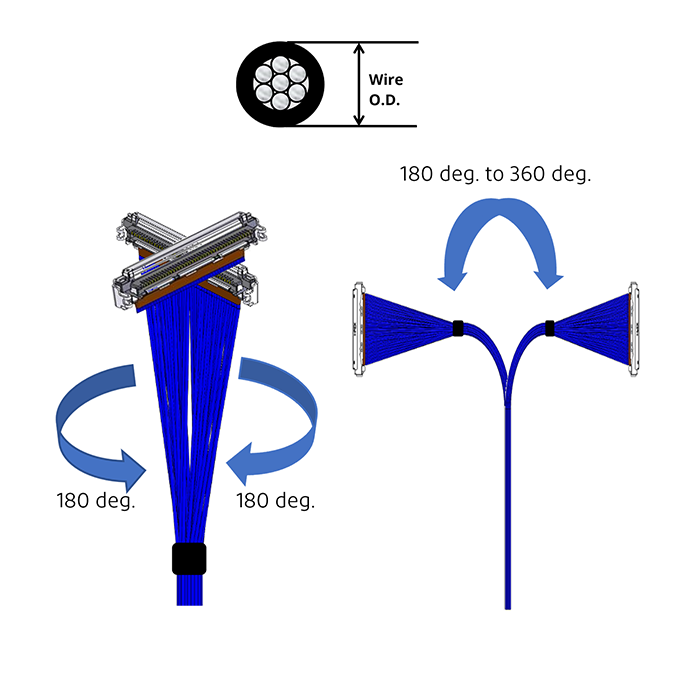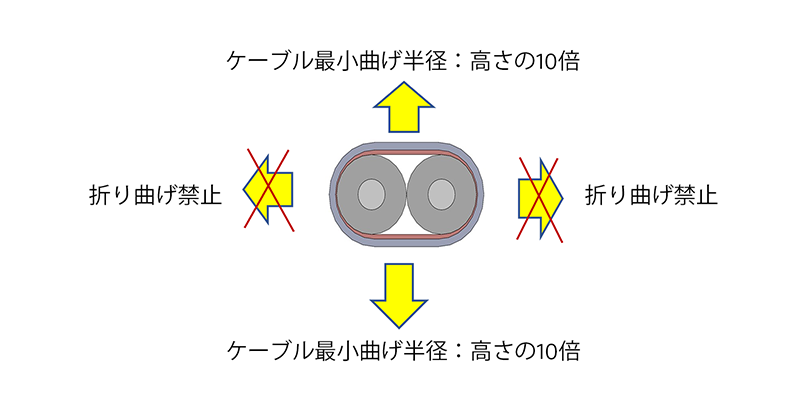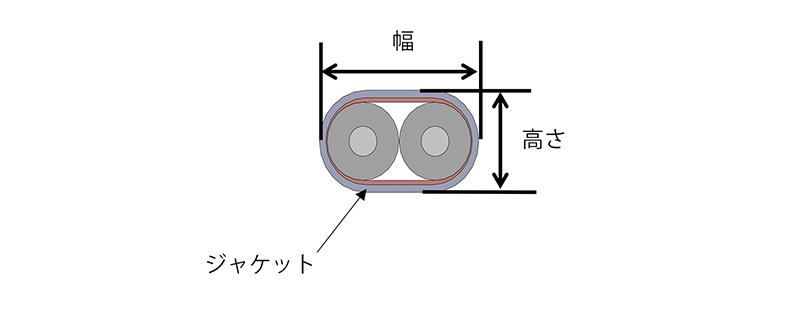ハーネスの曲がりや柔軟性、ねじれなどの条件
新たに小型ポータブル電子機器に設計する場合、高周波細線同軸および Twinax ケーブルアッセンブリの曲げおよび屈曲特性を考慮することが重要です。最小曲げ半径は、細線同軸ケーブルとTwinaxialケーブルの両方が指定されており、これらのケーブルが損傷を受けることなく、かつ高いシグナルインテグリティを維持したまま繰り返し曲げることができる強さを決定するパラメータです。最小曲げ半径は通常、ミリメートル単位で測定されます。マイクロ同軸ケーブルの典型的な使用例は、ヒンジを使用するシステムでディスプレイとマザーボード間の接続を提供することです。超小型同軸ケーブルは、Y軸に沿ったケーブルの回転運動を許容するパラメータであるツイストにも対応しており、通常、度単位で測定されます。
細線同軸ケーブルに関しては、ケーブルの推奨最小曲げ半径は「ワイヤー外径の6倍」ですが、実際の仕様はお客様が選択した同軸ケーブルによって異なります。

細線同軸ケーブルは、負荷条件下でケーブルを+/-90度に曲げることができる試験治具を使用して、曲げと屈曲の性能をテストします。複数の曲げ、屈曲サイクルでケーブルにストレスを与え、一定のサイクル数後にケーブルのSパラメータを測定することを目的としています。曲げ、屈曲サイクル終了後のSパラメータ性能は、試験前の初期サンプルのSパラメータ性能と比較されます。また、ケーブルは試験サイクル終了時に断線を含む機械的故障がないか検査されます。細線同軸ケーブルの曲げ、屈曲性能は、以下の表1:
Bending radius/group |
Test sample ID (AWG#44)
|
Avg. |
||||
|
|
1 |
2 |
3 |
4 |
5 |
|
1mm / No.1 |
3.5K |
4.2K |
4.2K |
3.4K |
4.3K |
3.9K |
2mm / No.2 |
25K |
30K |
26K |
30K |
28K |
28K |
5mm / No.3 |
400K |
600K |
500K |
600K |
450K |
500K |
表1. 同軸ケーブルの屈曲性能
同様に、細線同軸ケーブルは、負荷条件下でケーブルを Z 軸に沿って+/-180 度回転、撚ることができる試験治具を使用して、撚り性能を試験します。複数の撚りサイクルでケーブルにストレスを与え、一定のサイクル数後にケーブルのSパラメータを測定することを目的としています。撚りサイクル終了後のSパラメータ性能は、試験前の初期サンプルのSパラメータ性能と比較されます。また、ケーブルは試験サイクルの終了時に、断線を含む機械的故障がないか検査されます。細線同軸ケーブルのツイストサイクル性能は、以下の表2:
Test condition |
Test sample ID (AWG#44) (times) |
Average |
||||
1 |
2 |
3 |
4 |
5 |
||
+/- 180 deg. |
>900K |
>900K |
>900K |
>900K |
>900K |
>900K |
表2. 同軸ケーブルの撚り性能
Twinaxialケーブルに関しては、ケーブルの構造上、以下のように高さ方向にのみ曲げや屈曲が制限されます。2本の導体は、ケーブル内の固体誘電体によって隔てられて並んで配置されているため、横方向に曲げるとケーブルに物理的な損傷を与え、電気的なパフォーマンスやデータのシグナルインテグリティに影響を与える可能性があります。
Twinaxialケーブルの最小曲げ半径は、下図のようにケーブルの高さの 10 倍と規定されています。


